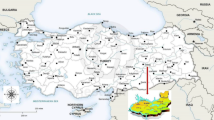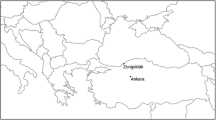Abstract
Airborne pollen triggers immune cells to release inflammatory chemical mediators, inducing respiratory conditions among susceptible individuals. This present study aimed at investigating the monthly depositional rate of pollen and fern spores with the aid of a modified Tauber pollen sampler, for a period of 1 year, examining airborne pollen–vegetation relationships and allergenic potentials of dominant airborne pollen types at selected study sites in Osun and Ogun states, South-western Nigeria. This involved collection, acetolysis and microscopy of residual solutions. Plants within the immediate vegetation of these sites were enumerated. Crude protein contents were extracted from pollen of Tridax procumbens L. (dominant in Osun state) and Alchornea cordifolia (Schum. & Thonn.) Mull. Arg. (dominant in Osun and Ogun states), used in Mus musculus sensitization. Blood samples were obtained from the pre-orbital vein of M. musculus L., processed for haematological (differential and total white blood cell counts) and serological studies. ELISA was employed in measuring the levels of serological parameters: IgE and cytokines (TNF-α, IL-5 and IL-13). Statistical significance (P < .05) was tested in the correlation between the levels of haematological and serological parameters elicited by each test group, differences between the levels of haematological and serological parameters elicited by each test group and those of the control, as well as at varied sensitization periods. In the results obtained, airborne pollen types of A. cordifolia, T. procumbens, Elaeis guineensis Jacq. and Poaceae were dominant in Osun state; A. cordifolia, Senna sp. and Poaceae were dominant in Ogun state. Spores of Nephrolepis biserrata (Sw.) Schott, Pteris sp. and a trilete fern were also recovered. Some pollen types were produced by local plants at the study sites. Neutrophils, lymphocytes, monocytes and eosinophils were the identified differential white blood cells. Statistical significance was observed in the correlation between the levels of certain haematological and serological parameters elicited by the test groups, differences between the levels of certain haematological and serological parameters elicited by each test group and those of the control, as well as at some sensitization periods. Hair loss (alopecia) was observed on the skin of a M. musculus in the A. cordifolia test group. This study has identified potential pollen allergens at the study sites; hence, their allergenicity should be further conducted on humans.





Similar content being viewed by others
References
Abdulrahaman, A., Aruofor, O. S., Garuba, T., Kolawole, O. S., Olahan, G. S., & Oladele, F. A. (2015). Aeropalynological investigation of the University of Ilorin, Ilorin, Nigeria. Journal of Applied Science and Environmental Management, 19(1), 53–63.
Adekanmbi, O. H. (2009). Pollen grains of Asteraceae and analogous echinate grains. International Journal of Botany, 5(4), 295–300.
Adekanmbi, O. H., & Ogundipe, O. T. (2009). Pollen grains of Lagos lagoon swamp and hinter-land vegetation-1. International Journal of Botany, 5, 270–278.
Adekanmbi, O. H., & Ogundipe, O. T. (2010). Aeropalynological studies of the University of Lagos Campus, Nigeria. Notulae Scientia Biologicae, 2(4), 34–39.
Adeniyi, T. A., Adeonipekun, P. A., Olowokudejo, J. D., & Idowu, S. A. (2014). Airborne pollen records of Shomolu local government area in Lagos State. Notulae Scientia Biologicae, 6(4), 428–432.
Adeonipekun, A. P. (2012). Comparative aeropalynology of Ota, Nigeria. Journal of Ecology and the Natural Environment, 4(12), 314–320.
Agwu, C. O. C., & Osibe, E. E. (1992). Airborne palynomorphs of Nsukka during the months of February–April, 1990. Nigerian Journal of Botany, 5, 177–185.
Ahlawat, M., Dahiya, P., & Chaudhary, D. (2013). Allergenic pollen in the atmosphere of Rohtak city, Haryana (India): A pioneer study. Aerobiologia. https://doi.org/10.1007/s10453-013-9323-1.
Ajikah, L., Ogundipe, O. T., & Bamgboye, O. (2015). Palynological survey of airborne pollen and spores in the University of Lagos, Akoka campus, Southwestern Nigeria. Ife Journal of Science, 17(3), 643–655.
Ajikah, L. B., Alebiosu, O. S., Adekanmbi, O. H., Oshinlaja, E. O., & Ogundipe, O. T. (2017). Aeropalynological investigation of three local governments in Lagos, South West Nigeria. Nigerian Journal of Botany, 30(1), 107–119.
Alebiosu, O. S., Adekanmbi, O. H., Nodza, G. I., & Ogundipe, O. T. (2017). Aeropalynological study of two selected locations in North-Central Nigeria. Aerobiologia. https://doi.org/10.1007/s10453-017-9506-2.
Association of Analytical Chemists. (1990). Official methods of analysis (13th ed.). Washington: Association of Official Analytical Chemists.
Bastl, K., Kmenta, M., Pessi, A., Prank, M., Saarto, A., Sofiev, M., et al. (2016). First comparison of symptom data with allergen content (Bet v1 and Phl p5 measurements) and pollen data from four European regions during 2009–2011. Science of the Total Environment, 548, 229–235.
Bettiol, J., Bartsch, P., Louis, R., de Groote, D., Gevaerts, Y., Louis, E., et al. (2000). Cytokine production from peripheral whole blood in atopic and non-atopic asthmatics relationship with blood and sputum eosinophilia and serum IgE levels. Allergy, 55(12), 1134–1141.
Bosch, X., & Ramos-Casals, M. (2014). Granulocytes: Neutrophils, basophils, eosinophils. In N. Rose & I. Mackay (Eds.), The auto immune diseases (5th ed., pp. 201–211). Amsterdam: Elsevier.
Bradford, M. M. (1976). A rapid and sensitive for the quantitation of microgram quantities of protein utilizing the principle of protein-dye binding. Analytical Biochemistry, 72, 248–254.
Conejero, L., Hagaki, Y., Baeza, M. C., Varela-Nieto, I., & Zubeldia, J. M. (2007). Pollen induced airway inflammation, hyper-responsiveness and apoptosis in a murine model of allergy. Clinical and Experimental Allergy, 37, 331–338.
Dalziel, J. M. (1937). The useful plants of West Tropical Africa. London: Crown Overseas Agents for the Colonies.
Dearman, R. J., Hope, J. C., Hopkins, S. J., Debicki, R. J., & Kimber, I. (1993). Interleukin (IL-6) production by lymph node cells: An alternative endpoint for the local lymph node assay. Toxicology Methods, 3, 268–278.
Dearman, R. J., Scholes, E. W., Ramdin, L. S. P., Basketter, D. A., & Kimber, I. (1994). The local lymph node assay: An interlaboratory evaluation of Interleukin 6 (IL-6) production by draining lymph node cells. Journal of Applied Toxicology, 14, 287–291.
Dedeke, G. A., Ademolu, K. A., Ogunnaike, O., Fadeyi, M. O., & Otti, C. N. (2011). Impact of human urine contamination on soil biota. In Proceedings of the environmental management conference. Federal University of Agriculture, Abeokuta.
Eastham, R. D., & Slade, R. R. (1992). Clinical Haematology (7th ed., pp. 83–106). Oxford, England: Butterworth Heinemann Ltd. ISBN:0750613394.
Erdtman, G. (1969). Handbook of palynology. Copenhagen: Munksgaard.
Essien, B. C., & Agwu, C. O. C. (2013). Aeropalynological study of Anyigba, Kogi State, Nigeria. Standard Scientific Research and Essays, 1(13), 347–351.
Essien, B. C., & Aniama, S. O. (2014). Environmental impact analysis through aeropalynology, Kogi State, Nigeria. Standard Scientific Research and Essays, 2(3), 60–64.
Ezike, D. N., Nnamani, C. V., Ogundipe, O. T., & Adekanmbi, O. H. (2016). Airborne pollen and fungal spores in Garki, Abuja (North-Central Nigeria). Aerobiologia. https://doi.org/10.1007/s10453-016-9443-5.
Gabrielsson, S., Soderlund, A., Paulie, S., Rak, S., Vander Pouw Kraan, T. C. T. M., & Troye-Blomberg, M. (1998). Increased frequencies of allergen-induced interleukin-13-producing cells in atopic individuals during the pollen season. Scandinavian Journal of Immunology, 48, 429–435.
Gosling, W. D., Miller, C. S., & Livingstone, D. A. (2013). Atlas of the tropical West Africa pollen flora. Review of Paleobotany and Palynology, 199, 1–135.
Greiner, A. N., Hellings, P. W., Rotiroti, G., & Scadding, G. K. (2011). Allergic rhinitis. Lancet, 378, 2112–2122.
Hutchinson, J., & Dalziel, J. M. (1954). Flora of West Tropical Africa (Vol. vols 1 and 2). London: The White Friars Press Ltd.
International Study of Asthma and Allergies in Childhood. (1998). World wide variation in prevalence of symptoms of asthma, allergic rhino-conjunctivitis, and atopic eczema. ISSAC Steering Committee, 351, 1225–1232.
Janeway, C. A., Travers, P., Walport, M., & Shlomchik, M. J. (2005). Immunobiology: The immune system in health and disease (6th ed.). New York, USA and Oxon, UK: Garland Science Publishing. ISBN:0815341016
Kato, G., Takahashi, K., Tashiro, H., Kurata, K., Shirai, H., Kimura, S., et al. (2014). β2 adrenergic agonist attenuates house dust mite-induced allergic airway inflammation through dendritic cells. BMC Immunology, 15, 39.
Keay, R. W. J., Onochie, C. F. A., & Standfield, D. P. (1964). Nigerian Trees (Vol. 1). Ibadan: Department of Forest Research.
Moverare, R., Elfman, L., Stalenheim, G., & Bjornsson, E. (2000). Study of the Th1/Th2 balance, including IL-10 production, in cultures of peripheral blood mononuclear cells from birch-pollen-allergic patients. Allergy, 55, 171–175.
Nadimi, A. E., Ahmadi, J., & Mehrabian, M. (2008). Peripheral eosinophil count and allergy in patients with coronary artery disease. Acta Medica Indonesiana, 40(2), 74–77.
National Population Census. (2006). Federal Republic of Nigeria Official Gazzete, Lagos, Nigeria, 94(4), 10–12.
Njokuocha, R. C. (2006). Airborne pollen grains in Nsukka, Nigeria. Grana, 45, 73–80.
Oke, S. O., & Isichei, A. O. (1997). Floristic composition and structure of the fallow vegetation in Ile-Ife Area, Southwestern Nigeria. Nigeria Journal of Botany, 10, 37–50.
Olajuyigbe, A. O., Alinaitwe, P., Adegboyega, S. A., & Salubi, E. (2012). Spatial analysis of factors responsible for incidence of water borne diseases in Ile-Ife, Nigeria. Journal of Sustainable Society, 1(4), 96–113.
Razi, E., & Moosavi, G. A. (2010). Serum total IgE levels and total eosinophil counts: relationship with treatment response in patients with acute asthma. Jornal Brasileiro de Pneumologia, 36(1), 23–28.
Repa, A., Wild, C., Hufnagl, K., Winkler, B., Bohle, B., Pollak, A., et al. (2004). Influence of the route of sensitization on local and systemic immune responses in a murine model of type 1 allergy. Clinical and Experimental Immunology, 137(1), 12–18.
Sanderson, C. J. (1992). Interleukin-5, eosinophils, and disease. Blood, 79, 3101–3109.
Ščevkova, J., Dušička, J., Hrubiško, M., & Mičieta, K. (2015). Influence of airborne pollen counts and length of pollen season length of selected allergenic plants on the concentration of sIgE antibodies on the population of Bratislava, Slovakia. Annals of Agricultural and Environmental Medicine, 22(3), 451–455.
Senjobi, B. A., & Ogunkunle, O. A. (2010). Effect of land use on soil degradation and soil productivity decline on Alfisols and Ultisols in Ogun State in South Western, Nigeria. Agriculturae Conspectus Scientificus, 75(1), 9–19.
Singh, A. B., & Dahiya, P. (2008). Aerobiological researches on pollen and fungi in India during the last fifty years: An overview. Indian Journal of Allergy and Asthma Immunology, 22(1), 27–38.
Singh, A. B., & Kumar, P. (2004). Aerial pollen diversity in India and their clinical significance in allergic diseases. Indian Journal of Clinical Biochemistry, 19(2), 190–201.
Singh, A. B., & Mathur, C. (2012). An aerobiological perspective in allergy and asthma. Asia Pacific Allergy, 2(3), 210–222.
Soladoye, M. O., Osipitan, A. A., Sonibare, M. A., & Chukwuma, E. C. (2010). From vagabonds to ethnobotanical relevance: Weeds of the campus sites of Olabisi Onabanjo University, Ago-Iwoye, Nigeria. Ethnobotanical Leaflets, 14, 546–558.
Sowunmi, M. A. (1973). Pollen grains of Nigerian plants. Grana, 13(3), 145–186.
Sowunmi, M. A. (1995). Pollen of Nigerian plants. Grana, 34(2), 120–141.
Wills-Karp, M. (1999). Immunologic basis of antigen-induced airway hyperresponsiveness. Annual Review of Immunology, 17, 255–281.
World Health Organization. (1980). Manual of basic techniques for a Health laboratory: Part III. Haematology (pp. 397–406). World Health Organization, Geneva, Switzerland. Accent/Index Printers, England.
Ye, S. T., Zhang, J. T., Qiao, B. S., & Lu, Y. G. (1988). Airborne and allergenic pollen grains in China (1st ed.). Beijing: Scientific Press.
Acknowledgements
The invaluable support from TET fund in Nigeria for the sponsorship of this research through an award of grant is highly appreciated. The authors wish to thank Dr. Nnamdi Amaeze (Department of Zoology, University of Lagos) for his immense assistance in the identification of mice and Mr. Samuel Akindele (Department of Biochemistry, Nigerian Institute of Medical Research) for his guidance in the execution of the allergenicity study. We sincerely appreciate the efforts of Dr. Olubunmi Oyesiku (Department of Plant Science, Olabisi Onabanjo University, Ogun state) and Mr. Michael Akinropo (Department of Botany, Obafemi Awolowo University, Osun state) in the monthly collection of aerosamples.
Author information
Authors and Affiliations
Corresponding author
Rights and permissions
About this article
Cite this article
Adekanmbi, O.H., Alebiosu, O.S. & Adeiga, A.A. Aerofloral investigation and allergenic potentials of two dominant airborne pollen types at selected sites in South-western Nigeria. Aerobiologia 35, 27–44 (2019). https://doi.org/10.1007/s10453-018-9533-7
Received:
Accepted:
Published:
Issue Date:
DOI: https://doi.org/10.1007/s10453-018-9533-7




